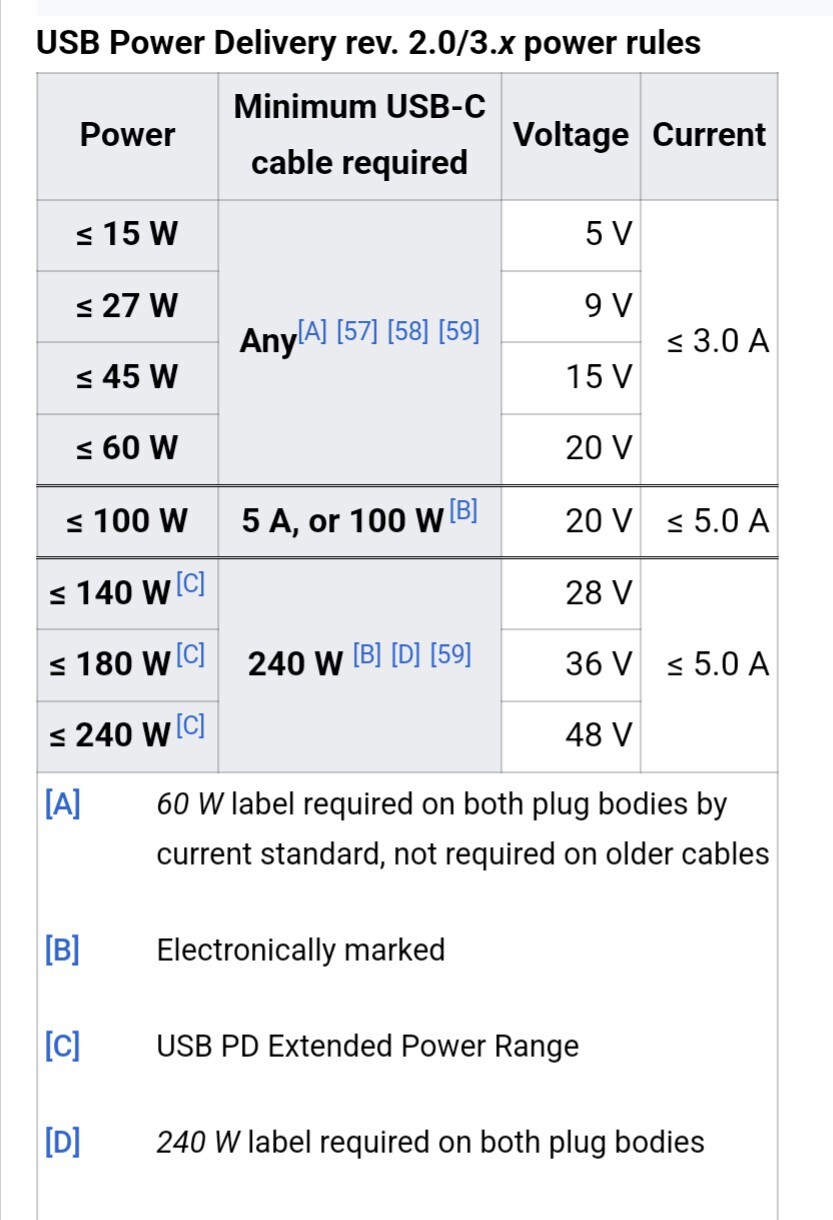I always see laptops come with larger bricks that have separate mains cable which plugs into the brick. Even if the adapter has some low power rating.
Example for comparison:

On the right is a standard laptop adapter.
Same price, same connector, same protocol, same power rating, far different size.
Why is that so?
Actually, the GaN adapter on the left also advertises itself as being meant for laptops, but by default, almost all laptops will come with something like the one on the right.
Or is it simply cheaper to manufacture while being sold for the same price?
GaN is newer technology and more expensive to manufacture. It can power laptops like anything else just in a much smaller package. I have a 65W GaN charger that charges my work laptop while on the go just as quickly as the official brick I leave in the office. You just need to pair it with a USB-PD rated cable that will handle the wattage your laptop requires. In my case, I ended up getting a 240W USB-C JSAUX cable. It’s stiff but does the job.
This is the main factor.
The second factor is manufacturer/model specific. Cleaning up the wave after conversion to DC is handled by the power adapter down to +/-5% tolerance for PD, for example. Manufacturers with lower tolerance designs will sometimes move the hardware for any additional refinement of the wave to the power adapter in order to reduce the size of the device.
One significant difference that has been missed here is that Laptops can and often do run on the power supply, while phones usually use the power purely to charge the battery.
It’s a significant difference as the laptop needs a stable electricity supply to supply all it’s components or the laptop would crash. That means not only does the brick need to dissipate heat, but it also needs to be able to deliver a stable continuous DC current. So as well as a transformer and rectifier (that together convert AC to the correct DC needed) there are smoothers and potentially capacitors to ensure a smooth continuous output even if the wall supply is janky.
If you turn off the power at the wall / unplug you often see any light on the power brick stay on - that is because of the capacitors and there is still a small amount of energy available to the laptop as it discharges.
While phones are mini computers they are usually designed to always run on the battery. Even when charging, the phone draws it’s power from the battery and it’s in built circuits to smooth the current; there isn’t usually the redundancy in a phone to switch between different supplies in the same way as a laptop. There isn’t also the expectation that they need to run off the wall continuously by users (even if users might plug their phone in and expect to continue to use it, they will find their phone shuts down if its at 0% and they push it beyond what the recharging battery can supply; a laptop would be expected to run solely on the wall not shut off).
Things are blurring now with USB C power supplies for laptops - but you will find the plug itself has more of the electronics built in or some of the functions of the power brick have moved into the laptop to reduce charger bulkiness. Look at how bulky a USB c charger plug is for a Mac - they’re not simple USB chargers you’d use for a phone or tablet, they’re bulky because they are also doing the smoothing and stabilisation people expect for their laptops.
Tl:Dr they’re different sizes because they’re doing different things. Basic chargers purely charges a battery, while laptop chargers both charge a battery and provide good quality supply to keep a laptop running optimally.
-
They don’t have to, I have Gan chargers that do a lot.
-
Less pressure on laptop manufactures to shrink as much.
-
Duty load: the big one.
You’re not just charging an hour at 20w and unplugging it, or tapering the charge, you could be using it at max rated output for days, that means much more stress, it needs to radiate more heat, and generally needs to be bigger.
As for fluctuating load, shouldn’t be as much of an issue, laptops often do their own power conditioning because the battery is fairly rough, and you’re going from 12-20v down to 5 and 3.3 then 1.6 and 1.3 to vcc for the chip, there’s plenty of filtering at each stage and they’re isolated by the smps controllers and input caps.
But pulling constant rated duty cycle basically doubles the size of power supplies normally, GaN technology helps a lot (which is why those little power bricks can do 100w+ now even though they got a lot more dense).
-
My guess is it’s similar to the electric motors they put in cars vs industrial motors… they can both put out X amount of power but the industrial ones (or in this case the laptop power) can do it continuously without overheating while the other can only output “up to” that power rating for a short time without burning up.
In this case though, the laptop power probably also outputs a higher voltage as well.
Pretty much this.
If you’ve ever tried using a phone charger to continuously power something at or near its rated maximum output, you’ll find that after a while the power becomes unstable and the charger often quite warm.
e.g. Continuously powering a Raspberry Pi or USB powered computer monitors.
and the charger often quite warm.
People hate on bricks, but they’re still around because of heat dissipation.
Charging a phone in an hour is a lot different than keeping a laptop going for 8 hrs.
Basically ‘duty cycle’…same reason electric heaters all put out 1500W but ones for larger rooms are ‘larger’. Big or small, they both put out 1500W, but the small ones can only do it for a few minutes at a time before having to cool off, while the larger ones can run for longer and heat up a big room more quickly.
higher voltage at the same power would actually make it more compact
Don’t forget safety. There’s a LOT of of sketchy ass gan (and non gan) chargers I wouldn’t even let in my house. Gan chargers being by so compact dont have enough space to safely insulate things.
Pro tip: eBay used laptop USB chargers are dirt cheap compared to a GaN charger + USB PD cable. I’ve put laptop chargers all around the house so I always have one available for my laptop, phone and Steam Deck.
Another tip: even if your laptop charger isn’t USB C, you can get a converter to make it a PD USB charger for a couple of £.
Hey, I’m interested in the last thing. Can you give me some details on how to do it? I’d love not to carry around the bulky stock charger.
I got it from Ali Express and hope this link works for you. Just look out for the size that fits your current laptop charger. Also check how many watts your laptop charger does, it needs to be able to output 65W if you want to charge a 65W device.
Ok, I guess I misinterpreted what you said. My laptop only has a DC barrel port. I want to charge it using any of the high wattage GaN chargers. To do that, I’ll need something that converts the USB-C to barrel, and does the voltage negotiations. But thanks anyway. Maybe this’ll help someone else.
Ah, I’ve never tried to convert it that way. Laptops all seem to have had USB charging for many years now.
Or is it simply cheaper to manufacture while being sold for the same price?
Yes, it’s mainly that. Most vendors don’t make their own power adaptors anyway, since there are strict requirements for power adaptors that are plugged into AC wall sockets in each country. The stuff inside the large brick is likely sourced from somewhere else, who has all those certifications worldwide. Note that it also uses standard AC power cable plugs. That large brick can be shipped worldwide by simply changing the AC cable it ships with.
The small GaN Brick is also outsourced, but since it is smaller it is probably more expensive to build. However, the AC plug is integrated into it, which means the seller has to stock physically separate units for each plug type if they want to ship worldwide.
As far as the price is concerned, this one shop is selling them all at around the same price, but I bet the MSRP on the Lenovo one is much higher, because of the brand. The parts inside the Lenovo one are probably cheaper.
Heat soak. A laptop may be expected to run 24/7. The larger bricks can dissipate the heat. A GaN charger can do it as well, but most of them have a heat soak point where they stop delivering full power
My uneducated guess is money.
Manufacturers likely have factories (either theirs or a contracted company’s) where they can mass produce the power bricks for a low cost. Upgrading to a USB power supply doesn’t offer significant benefits compared to the power brick of similar wattage, and the up-front cost of setting up a new supplier is financially unjustified. The old technology works just as well, so why change?
High power USB is still a relatively new technology. I’m sure it will proliferate, but the consumer market has a fuckton of inertia.
I think it’s mainly marketing and consumer expectations. Your phone is smaller, so it feels like it should have a smaller adapter to be more convenient. It takes less convincing for a large adapter when you’re already carrying around a laptop in a bag.
Part of it is also history. It used to be that you needed much higher power dissipation so your adapter needs to be physically larger for a laptop to shed that heat, but nowadays laptops are more efficient and phones draw more power than they used to. Still, the idea that a phone charger should be smaller still feels right to the consumer, and much effort has been expended to ensure that they are small to accommodate consumer expectations.
People carry around laptops in bags. People carry around their phones in their pockets. This is another reason why mobile chargers are often smaller. They need to be, because it’s more likely that you’ll be carrying a phone charger in your pocket than in a laptop bag.
Also, making a powerful adapter smaller costs more money. It’s a way to lower the overall price of a laptop.
deleted by creator
No USB power plug operates at 5 V when providing 65 Watts. That would be 13 Amps. Both power plugs most likey use 15 or 20 volts internally. 19 volts is not allowed over USB.
Edit: Here is a short summary of the USB-PD spec from Wikipedia

Volts are not a unit of power. Watts are a unit of power.
The 5V applies only to 4-pin type-A and type-B connectors.
USB Power Delivery over a regular USB-C-compliant cable delivers a variable current of up to 3A, using discrete voltages of 5V for up to 15W of power, 9V for up to 27W, 12V for up to 48W, and 20V for up to 60W.
Higher powers require dedicated USB PD-compliant cables that can handle up to 240W at a voltage of 48V.
Voltage is the same but wattage is not.
Most of your phone chargers will be 65w or less while a laptop isn’t going to charge on fewer than 100w most of the time.Which is why I said power rating as opposed to voltage or current.
In general with electrical things, the longer it will be operating at a higher usage the bigger the need for heat dissapation and more robust parts. Phones of the same power rating still have less juice, as in smaller batteries, and have less power usage overall.
While the power rating may be the same, the volume of energy is not the same. Like running water through a straw and a hose can have the same pressure but way more water is going through the hose.
Watts are part of the electrical properties along with volts and amps. Laptop chargers have the same watts and volts but more amps.Edit: I got the calculation wrong, but the point is that more power goes through that laptop brick in a shorter amount of time and it needs to both handle the higher load and dissapate more heat.
same watts and volts but more amps
Laws of physics: defeated.
If I’m misremembering the details, feel free to clarify.
The equation to determine watts is P=VA
If you have the same voltage and a higher amperage, then by definition you have a higher wattage.
Dammit, thought they all multiplied into a fourth thing, thanks.
Wattage = V x A.
They’re pointing out that it’s impossible to hold both wattage and voltage constant while changing the amperage.
Watts are part of the electrical properties along with volts and amps. Laptop chargers have the same watts and volts but more amps.This is incorrect, Watts (power) is the product of amps * volts. The formula is P = IV. Anything with the same power and voltage will have the same amps.
The volume of power consumed would be Watts * time and gets you to capacity and usage units like watt-hours.
far different size.
Size first. Power electronics don’t have the same miniaturization benefits (or expectations) for laptops as they do for phones. Some factor here is that there’s just a different convention for these two different types of devices.
larger bricks that have separate mains cable which plugs into the brick
There’s a manufacturing benefit having one circuit where you can just change the mains cable for length or country adaptor types. High probably the wall warts have the same ability, but it isn’t as obvious if the plastic parts are press fit.
Why is that so?
Some laptops could run off of 65 w, but only the very basic types. An Alienware m18 R2 gaming laptop has a 280 w adaptor and it isn’t close to the same size or price as a phone adaptor.
Same for phones. 65 w is pretty beefy for a phone charger. It will come down to the requirements of the device.
Generally speaking, a charger can have more amps than the phone or laptop requires and that’s usually okay. The voltage is what you have to be careful about. 5v is kind of a common electronics safe voltage. Good chance all these “universals” chargers are 5v.
Again, something like an Alienware m18 R2 is going to require more than 5v.
Or is it simply cheaper to manufacture while being sold for the same price?
Good chance of that. Much easier to price fix on big warehouse type online marketplaces.
Really well written. The USB power delivery specification allows devices to negotiate different voltages. That’s why if you have a device of multiple ports, and you plug in a new device to charge, all of the devices stopped charging for a moment will they negotiate again.
I’ll add, a lot of the phone chargers cannot sustain their maximum power output all day. They’re going to soak in heat, the large bricks are also a function of heat dissipation anticipating 24/7 usage
Sometimes the power rating of these chargers is created by math, not by physics. And then it is the sellers who do that math :)










